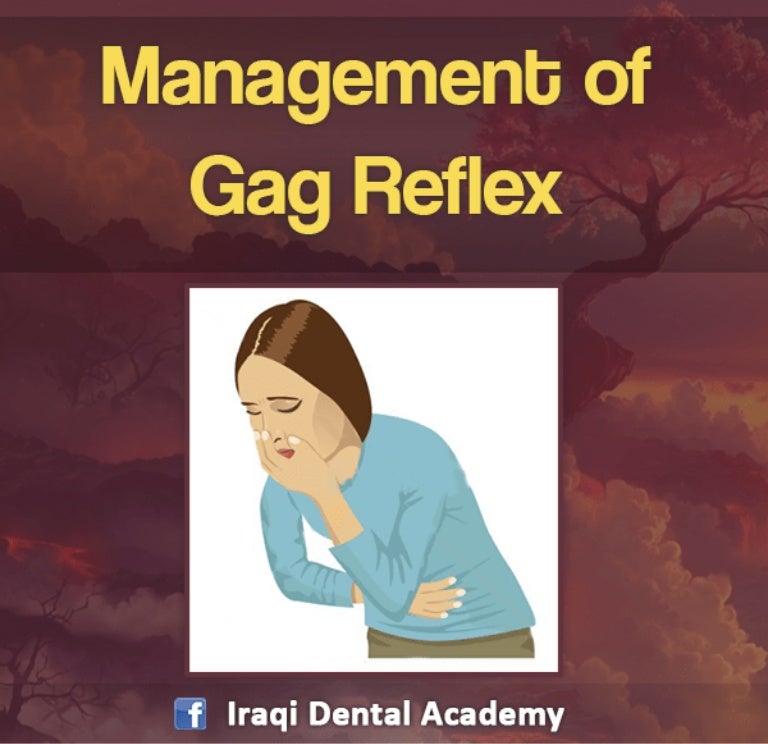

In order to handle a patient with gagging, the clinician has to understand its various underlying aetiological mechanisms, analyse the phenomenon and correct it by using therapeutic methods and techniques adapted to the respective aetiology. Gagging‐related problems accounted for approximately 20% of dental avoidance cases ( Saita 2010). For some patients however, severe gagging can be elicited by the dentist's fingers or instruments contacting the oral mucosa or even by non‐tactile stimuli ( Bassi 2004). Many dental procedures such as obtaining maxillary and mandibular impressions, mapping the posterior vibrating line for complete dentures, preparation of cavities, crowns or root canal treatment for posterior teeth, extraction of third molars, taking intra‐oral radiographs especially for the posterior teeth may cause exaggerated gag reflex ( Murthy 2011). In such cases, any therapeutic procedure will be clinically challenging, both for the dentist who is unable to perform quality work, and for the patient who is unable to overcome the sensation, thus rendering the procedure difficult, even impossible ( Ardelean 2003). Have you ever used salt? What has worked for your patients? Let us know on our facebook Group, Facebook Page or Instagram.An exaggerated gag reflex is a known hindrance to dental procedures ( Kumar 2011). I’m sure this works however feel asking my patients to force themselves to dry retch in the name of dentistry multiple times a day is a long shot. I remember being told in university that one way to work past the gag reflex is to get your patients to systematically sensitise the area leading to a lowered response. This means that for complex situations and severe gaggers nitrous is going to be the number 1 option (short of sedation itself). In the study that suggests salt isn’t particularly successful it also clearly shows that Nitrous Oxide is. Although it’s arguable if it helps the patient or just helps us think we’re helping. All of these things help distract from the mouth and can help in the gagging situation. “Focus your breathing”, “wiggle your toes”. It’s something most dentists almost intuitively say. Personally, i’m yet to try this because the thought of a numb tongue makes me gag. Numbing the back of the tongue and soft palate can help lower the sensitivity of these regions allowing you to work. Letting them know you have a trick to help and being confident in that delivery gives them hope, and it seems to work. What I think really makes this work is distraction and your confidence. To be clear – this is NOT evidence based medicine, it’s a likely placebo based on my experience which i have seen work wonders for my patients! In fact, the best evidence I could find was that it is not significantly different to control. Strange,as the reflex is often triggered by posterior tongue (glossopharyngeal) and soft palate (trigeminal).

There is suggestion that the sensitisation of the chorda tympani blocks the sensation of the gag reflex. I have no idea if this has a true physiological basis to it. The result was incredible – i proceeded to fail at taking 3 lower bilateral DES impressions in a row, all without a gag at all! It was explained to the patient that the salt activates the nerves in the tongue leading to inhibition of the sensory component which would otherwise trigger the gag reflex. She suggests we sprinkle a small amount of salt on the back of the tongue. I believe I learnt this from a tutor in uni. Salt on the Tongue Just sprinkle a bit on the tongue and you’ll be amazed To help the patient get through these appointments there are a few ‘tricks’ But don’t forget, it’s the patient who’s really struggling here. Often their tongue is large, wandering and reactive.

I needed to make a lower partial with bilateral distal end saddles – I needed a perfect impression!Ī patient who gags can really make things difficult. He was great to treat however had warned me from day on, “I have a terrible gag reflex, last time I almost threw up!”Īs a dental student this sent shivers down my spine.

I was making a set or partials for a lovely patient. It’s often the modifying patient factors that really put a spin on your day. Most things with a little practice and repetition become quite easy.


 0 kommentar(er)
0 kommentar(er)
